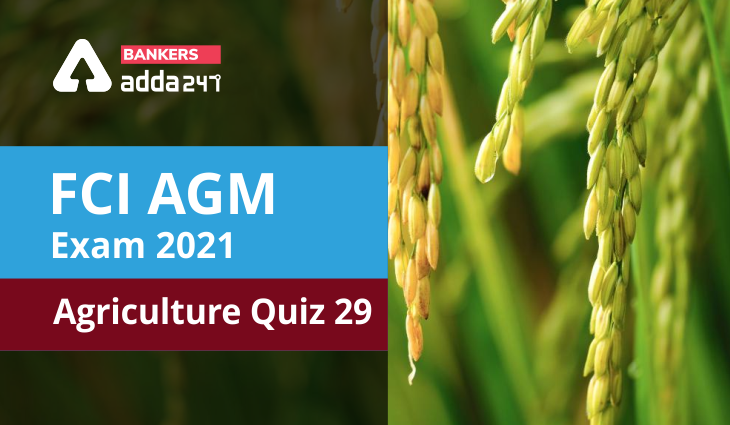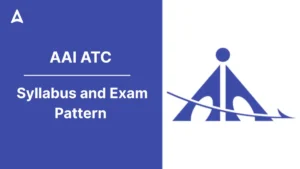FCI Recruitment 2021: Good News for all the aspirants, Bankers Adda team is coming up with Exclusive Questions of Agriculture for FCI AGM 2021 on the Adda247 app also, so download the Adda247 App now to attempt these quizzes. We have started this series on 18th March 2021. So, do attempt it daily and crack the FCI AGM 2021 Exam.
Q1. National Project on Management of Soil Health & Fertilizer was started in
- 2010-11
- 2002-03
- 2008-09
- 2014-15
- None of these
Explanation:- “National Project on Management of Soil Health & Fertility” (NPMSH&F) has been taken up from 2008-09 to promote the balanced and judicious use of fertilizer in conjunction with organic manure on a soil test basis with an outlay of Rs. 429.85 crore during the 11th plan period.
Q2. Drip irrigation system saving water
- 80-90%
- 50-60%
- 10-20%
- 30-50%
- None of these
Explanation:- Drip irrigation systems are much more efficient, using 30 to 50 percent less water than normal sprinkler systems.
Q3. Purposes of golden rice provide a new, alternative intervention to combat……………deficiency.
- Vitamin B
- Vitamin A
- Vitamin K
- Iron
- None of these
Explanation:- Golden Rice, which was developed in the hopes of combatting that problem by a team of European scientists in the late ’90s, was genetically modified to provide an essential nutrient that white rice lacks: beta-carotene, which is converted into vitamin A in the body.
Q4. The average milling recovery of Rice is
- 80%
- 90%
- 60%
- 45%
- None of these
Explanation:- The maximum milling recovery is 69-70% depending on rice variety, but because of grain imperfections and the presence of unfilled grains, commercial millers are happy when they achieve 65% milling recovery. Some village-type rice mills have 55% or lower milling recovery.
Q5. Greenhouse gases produced from agriculture
- 80%
- 20%
- 35%
- 10%
- None of these
Explanation:- Agriculture is both a victim of and a contributor to climate change. On the one hand, agricultural activities contribute approximately 35 percent of total greenhouse gas emissions, mainly due to the use of chemical fertilizers, pesticides, and animal wastes.
Q6. The origin place of Wheat
- Mexico
- India
- South West Asia
- South East Asia
- None of these
Explanation:- Wheat is believed to have originated in southwestern Asia.
Q7. In cereal crops, general recommendation fertilizer doses (N:P:K Ratio)
- 1:2:1
- 4:1:2
- 4:2:1
- 1:2:2
- None of these
Explanation:- The ideal NPK ratio for cereals should be 4:2:1.
Q8. The most prominent cropping pattern in India is
- Rice-Maize
- Rice-Sugarcane
- Rice-Wheat
- Rice-Moong
- None of these
Explanation:- Rice–Wheat cropping system which involves the growing of rice and wheat crops on the. the same piece of land in different seasons in a year has emerged as a major production system. in the Indo-Gangetic Plains of South Asia over the past nearly three decades.
Q9. The average number of irrigation required in wheat crop
- 3
- 5
- 2
- 5
- None of these
Explanation:- The crop requires 4 – 6 irrigations depending on the soil type and rainfall. The wheat crop requires a minimum of 5 irrigations at the following critical stages. Crown root initiation and flowering are the most critical stages. Water stagnation should be avoided at the time of germination.
Q10. Maize is known as
- King of cereals
- Staple food
- Poor food
- Queen of cereals
- None of these
Explanation:- Maize (Zea mays L.) is one of the most versatile emerging crop shaving wider adaptability under varied agro-climatic conditions. Globally, maize is known as the queen of cereals because it has the highest genetic yield potential among the cereals.
Also Attempt:




 GA Capsule for SBI Clerk Mains 2025, Dow...
GA Capsule for SBI Clerk Mains 2025, Dow...
 The Hindu Review October 2022: Download ...
The Hindu Review October 2022: Download ...
 AAI ATC Syllabus 2025 and Exam Pattern f...
AAI ATC Syllabus 2025 and Exam Pattern f...


